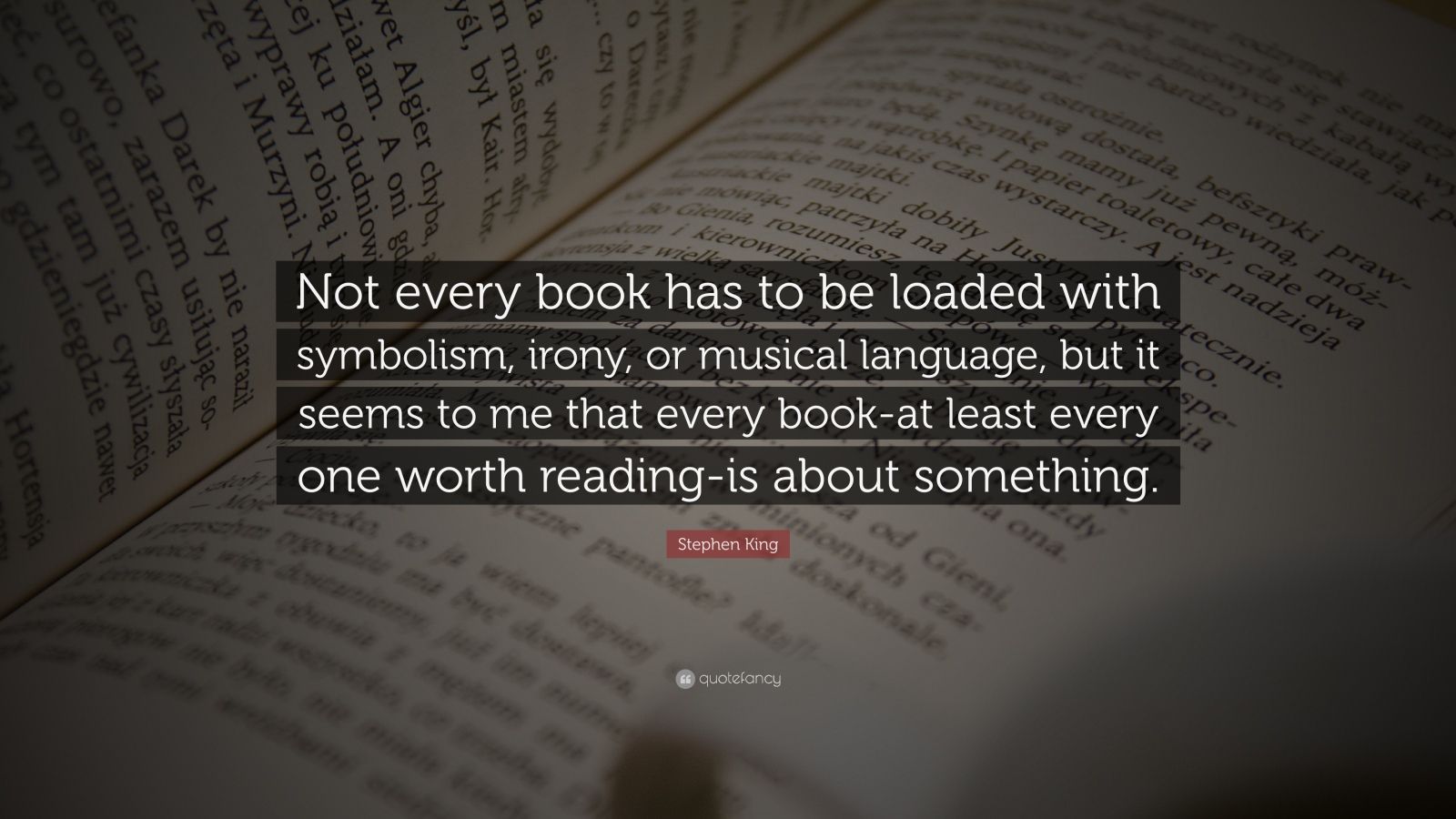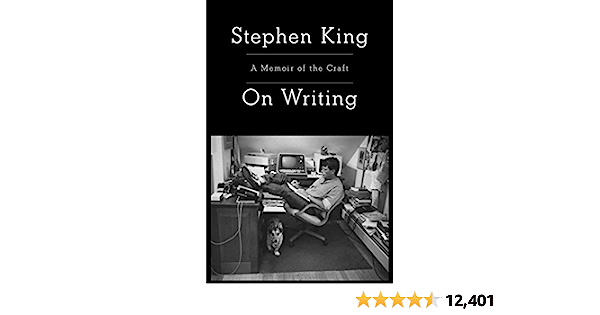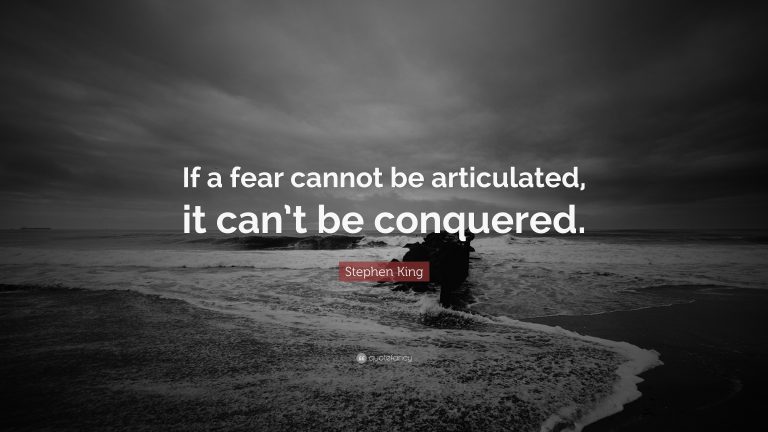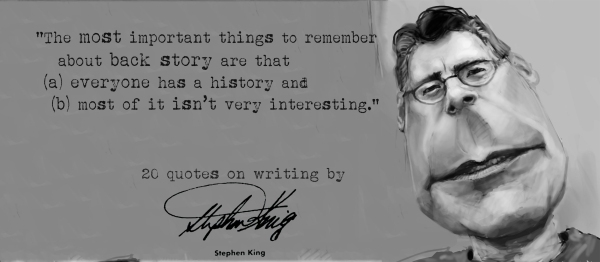Which Stephen King Quotes Are Perfect For Analyzing Symbolism In Literature?
If you’re a literature enthusiast, you know that analyzing symbolism in literature can unlock a whole new level of understanding and appreciation for a work. And when it comes to authors who excel at crafting intricate symbols, Stephen King is undoubtedly at the top of the list. But with such a vast collection of works, which Stephen King quotes should you turn to for a deep dive into symbolism? Well, fear not, because we’ve got you covered! In this article, we’ll explore some of the most thought-provoking Stephen King quotes that are perfect for analyzing symbolism in literature.
When it comes to symbolism, Stephen King is a master of crafting hidden meanings within his stories. His vivid imagination and ability to tap into the deepest fears and desires of humanity create a rich tapestry of symbols that invite readers to explore the depths of their own interpretations. From the haunting imagery of “The Shining” to the eerie creatures of “IT,” King’s work is a treasure trove for symbolism enthusiasts. So, grab your magnifying glass and get ready to dissect some powerful quotes that will take your literary analysis to the next level. Let’s dive into the world of Stephen King and unravel the hidden symbolism beneath the surface of his words.

Which Stephen King Quotes Are Perfect for Analyzing Symbolism in Literature?
Stephen King is a renowned author known for his captivating storytelling and ability to incorporate symbolism into his works. His quotes not only offer insights into his writing process but also provide valuable material for analyzing symbolism in literature. In this article, we will delve into some of Stephen King’s most thought-provoking quotes that can be used as a lens to explore symbolism in various literary works.
1. The Power of Fear
Stephen King often explores the theme of fear in his novels, and his quotes on this topic can be instrumental in understanding the symbolic representation of fear in literature. One of his notable quotes is, “We make up horrors to help us cope with the real ones.” This quote suggests that horror stories and their elements serve as a metaphorical tool to confront and process the fears we encounter in reality. By analyzing how fear is depicted in literature, we can gain a deeper understanding of the human psyche and the societal fears that shape our world.
Another quote by Stephen King that sheds light on the power of fear is, “Nightmares exist outside of logic, and there’s little fun to be had in explanations; they’re antithetical to the poetry of fear.” This quote suggests that the true essence of fear lies in its irrationality and inexplicability. When exploring symbolism related to fear in literature, it is crucial to consider how authors utilize the illogical and mysterious aspects of fear to create a sense of unease and suspense.
1.1 Fear as a Symbolic Representation
Fear can often serve as a symbol in literature, representing deeper themes or emotions. For example, in Edgar Allan Poe’s “The Tell-Tale Heart,” the relentless fear experienced by the narrator symbolizes guilt and the haunting presence of the past. By examining how fear is used symbolically in various works, readers can uncover hidden meanings and gain a deeper appreciation for the author’s intentions.
When analyzing symbolism related to fear, it is important to consider the context and cultural significance of specific fears. Stephen King’s quote, “Monsters are real, and ghosts are real too. They live inside us, and sometimes, they win,” highlights how certain fears are deeply ingrained in human nature and can manifest in various forms. Exploring how authors utilize these fears and transform them into symbolic representations can provide valuable insights into the human condition and the universal experiences we all share.
2. The Dark Side of Human Nature
Stephen King’s quotes often delve into the darker aspects of human nature, allowing readers to explore the symbolic representation of human vices and flaws in literature. One notable quote is, “Monsters are real, and ghosts are real too. They live inside us, and sometimes, they win.” This quote suggests that the true monsters and ghosts reside within us, representing our inner demons and the potential for darkness that exists in every individual. By analyzing how authors portray these internal struggles symbolically, readers can gain a deeper understanding of the complexities of human nature.
Another quote by Stephen King that explores the dark side of human nature is, “We lie best when we lie to ourselves.” This quote sheds light on the self-deception that often accompanies the human condition. When examining symbolism related to human flaws and vices, it is essential to consider how characters’ internal conflicts and self-deception are depicted symbolically to highlight the inherent contradictions and complexities of human behavior.
2.1 Symbolism of Human Flaws
Symbolism related to human flaws can be found in numerous literary works, shedding light on the universal struggles and imperfections that define the human experience. For example, in William Shakespeare’s “Macbeth,” the character of Lady Macbeth symbolizes the destructive nature of unchecked ambition. By examining how authors use symbolism to represent human flaws, readers can gain insights into the consequences of these flaws and the moral dilemmas they create.
Stephen King’s quote, “We make up horrors to help us cope with the real ones,” can also be applied to the symbolic representation of human flaws. By exploring how authors utilize symbolism to confront and address these flaws, readers can engage in introspection and contemplate their own shortcomings and vulnerabilities. Symbolism becomes a powerful tool for self-reflection and personal growth.
3. The Transformative Power of Redemption
Stephen King’s quotes often touch on the theme of redemption, offering valuable insights into the symbolic representation of redemption in literature. One of his notable quotes is, “Redemption is something you have to fight for in a very personal, down-dirty way.” This quote suggests that true redemption requires personal effort and a willingness to confront one’s past mistakes. By analyzing how redemption is depicted symbolically in literature, readers can explore the transformative power of forgiveness and growth.
Another quote by Stephen King that explores the theme of redemption is, “It’s not about what you have done, it’s about what you become.” This quote emphasizes the importance of personal growth and the potential for change. When examining symbolism related to redemption, it is essential to consider how authors utilize metaphors and allegories to depict characters’ transformative journeys towards redemption.
3.1 Symbolic Representations of Redemption
Symbolism related to redemption can be found in various literary works, offering insights into the possibilities of personal growth and second chances. For example, in Charles Dickens’ “A Christmas Carol,” the character of Ebenezer Scrooge symbolizes the transformative power of redemption as he undergoes a profound change of heart. By exploring how authors utilize symbolism to represent redemption, readers can reflect on their own capacity for change and the potential for personal redemption.
Stephen King’s quote, “Redemption is something you have to fight for in a very personal, down-dirty way,” highlights the challenging nature of the redemption process. Symbolism becomes a tool for conveying the struggles and hardships that accompany the journey towards redemption. By analyzing these symbolic representations, readers can gain insights into the complexities of the human experience and the power of personal transformation.
In conclusion, Stephen King’s quotes offer valuable insights into the symbolism present in literature. By analyzing his quotes on fear, the dark side of human nature, and redemption, readers can explore deeper meanings and uncover the hidden layers of symbolism in various literary works. Symbolism becomes a powerful tool for understanding the human condition and the universal themes that resonate with readers. Through the exploration of symbolism, readers can engage in introspection, gain new perspectives, and appreciate the intricacies of storytelling.
Key Takeaways: Which Stephen King quotes are perfect for analyzing symbolism in literature?
- Stephen King’s novel “The Shining” contains a quote that beautifully showcases the symbolism of the haunted hotel: “The Overlook was a ghost ship, adrift on a spectral sea.”
- In “IT,” King writes, “We lie best when we lie to ourselves.” This quote explores the theme of self-deception and the masks people wear in society.
- “Carrie” features the quote, “The town smelled of gasoline and burnt popcorn.” This symbolism represents both destruction and the loss of innocence.
- “The Green Mile” includes the quote, “Sometimes the past just catches up with you, whether you want it to or not.” This quote delves into the concept of karma and the consequences of one’s actions.
- From “The Dark Tower” series, King states, “Ka is a wheel.” This quote highlights the cyclical nature of life and the repetitive patterns that characters experience.
Frequently Asked Questions
What are some Stephen King quotes that can be analyzed for symbolism in literature?
Stephen King is a master of symbolism in his writing, and many of his quotes can be analyzed for their deeper meaning. Here are five quotes that are perfect for exploring symbolism in literature:
1. “Monsters are real, and ghosts are real too. They live inside us, and sometimes, they win.” This quote from King’s novel “The Shining” is a powerful example of how he uses supernatural elements to represent deeper psychological and emotional struggles. The monsters and ghosts in this quote symbolize the inner demons that haunt us all.
2. “The man in black fled across the desert, and the gunslinger followed.” This opening line from King’s “The Dark Tower” series is rich with symbolism. The man in black represents evil and chaos, while the gunslinger symbolizes the pursuit of justice and order. This quote sets the stage for a battle between these opposing forces.
How can Stephen King quotes be analyzed for symbolism in literature?
Analyzing Stephen King quotes for symbolism in literature requires a close examination of the context and themes of his works. Here are two steps to help you analyze these quotes:
1. Identify the symbols: Look for recurring motifs, objects, or characters that carry deeper meaning throughout the story. These symbols can represent abstract ideas, emotions, or societal issues. Pay attention to how they are described and how they interact with other elements in the narrative.
2. Interpret the symbolism: Once you have identified the symbols, think about what they might represent in the larger context of the story. Consider the themes and messages that King is exploring in his work. Symbolism can often be open to interpretation, so look for clues in the text and consider different perspectives to gain a deeper understanding of the author’s intent.
What other Stephen King works contain symbolism that can be analyzed?
Stephen King’s vast body of work is filled with symbolism that can be analyzed and interpreted. Here are three other works worth exploring:
1. “Carrie”: This novel tells the story of a teenage girl with telekinetic powers who seeks revenge on her tormentors. The iconic prom scene, where Carrie unleashes her powers, is a powerful symbol of the destructive force that can result from years of bullying and mistreatment.
2. “The Stand”: In this epic post-apocalyptic novel, symbolism is woven throughout the narrative. The battle between good and evil is represented by the characters of Mother Abagail and Randall Flagg, who embody the forces of light and darkness, respectively.
3. “The Green Mile”: This novel explores themes of justice, redemption, and the supernatural. The green mile itself, the stretch of death row where inmates await execution, becomes a symbol of the human capacity for both cruelty and compassion.
Why is symbolism important in literature?
Symbolism plays a crucial role in literature as it adds depth and complexity to the storytelling. It allows authors to convey abstract ideas, emotions, and themes through concrete symbols that readers can interpret and relate to. Symbolism enhances the overall meaning of a work and invites readers to engage in deeper analysis and interpretation.
By using symbols, authors can communicate complex concepts and evoke powerful emotions in their readers. It also allows for multiple layers of meaning, as symbols can have different interpretations based on individual experiences and perspectives. Symbolism adds richness and nuance to literature, enriching the reading experience and encouraging readers to think critically about the text.
How can analyzing symbolism in literature enhance the reading experience?
When readers analyze symbolism in literature, they gain a deeper understanding of the text and the author’s intentions. It allows readers to uncover hidden meanings and themes that may not be immediately apparent. By engaging with the symbols and their interpretations, readers can develop a more nuanced interpretation of the work and appreciate the complexity of the storytelling.
Additionally, analyzing symbolism encourages readers to think critically and make connections between different elements of the text. It can spark discussion and debate, as different readers may have different interpretations of the symbols. This enhances the reading experience by fostering a deeper engagement with the material and encouraging readers to explore their own perspectives and insights.
“What is Symbolism?”: A Literary Guide for English Teachers and Students
Final Thought: Exploring Symbolism with Stephen King Quotes
As we delve into the world of literature and symbolism, we discover that Stephen King’s quotes offer a treasure trove of insights and perspectives. From his gripping novels to his thought-provoking interviews, King’s words resonate with readers and provide ample material for analyzing symbolism in literature. By examining his quotes, we can uncover hidden meanings, unravel intricate metaphors, and gain a deeper understanding of the power of symbolism in storytelling.
One of Stephen King’s notable quotes that exemplifies the use of symbolism is, “Monsters are real, and ghosts are real too. They live inside us, and sometimes, they win.” This quote not only captures the essence of fear and darkness in King’s works but also symbolizes the internal struggles we face in our lives. It reminds us that our personal demons and fears can consume us if we allow them to overpower our thoughts and actions. This quote serves as a reminder to analyze the symbolic representations of monsters and ghosts in literature, how they reflect our innermost fears and desires, and the impact they have on the human psyche.
Another quote that showcases King’s mastery of symbolism is, “Books are a uniquely portable magic.” This powerful statement goes beyond the literal meaning of books as physical objects and delves into the transformative power of storytelling. Symbolically, books represent knowledge, imagination, and the ability to transport us to different worlds. They hold the power to inspire, educate, and ignite our inner magic. Analyzing the symbolism of books in literature allows us to explore the profound impact of storytelling on our lives, the way it shapes our perspectives, and the magic it brings to our everyday existence.
In conclusion, Stephen King’s quotes provide a rich tapestry of symbolism that invites readers to embark on a journey of discovery and interpretation. Through his words, we can unravel the intricate layers of meaning, delve into the depths of human emotions, and gain valuable insights into the power of symbolism in literature. So, the next time you delve into a Stephen King novel or stumble upon one of his captivating quotes, take a moment to reflect on the hidden symbolism within and unlock the magic that lies beneath the surface.






